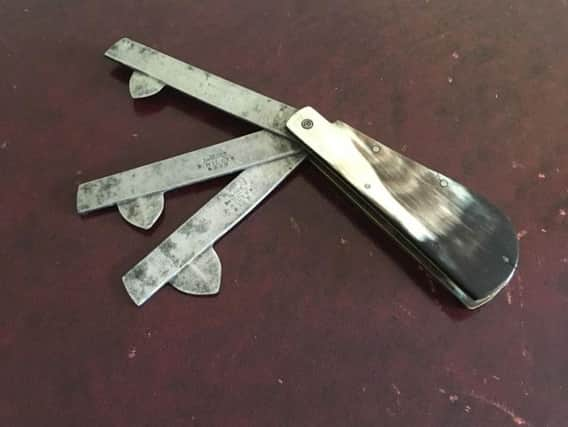When I opened the blades it became evident it was not a penknife a quick search of Google revealed it was a fleam - Julian Norton


The lamp, in the shape of a bulldog with a lampshade on its head, which is looking at me as I write this column, is probably the most memorable. It was a gift to remind me of a favourite patient called Elsie. One of my kids keeps asking: “How long is that ridiculous lamp going to stay in the kitchen?”
“As long as it makes me smile,” is my answer.
Elsie’s double keeps putting a smile on my face and so remains supervising each mealtime in our house.
Advertisement
Hide AdAdvertisement
Hide Ad

But I had another unusual gift recently. It came from the widow of Trevor, a neighbour of my parents, and it used to belong to her husband.
When I was a child, I spent many a happy summer day at their house, learning about ferrets, whittling sticks with penknives and pointing air rifles at tin cans with their son, Jason. Trevor was very keen that this object was passed on to me.
I hope that people, when they sat down to enjoy their Christmas dinner spared a thought for those who put it there - Jill ThorpMince pies and a half-opened bottle of merlot may not be conventional medicines but they were best I'd dispensed all year - Julian Norton
It looked just like a beautifully crafted penknife, with a perfect bone handle and smoothly inset pins to keep the blades in place.
Advertisement
Hide AdAdvertisement
Hide AdBut when I opened the blades, it became evident it was not a penknife. The three blades did have a sharp edge, but curved and triangular with a pointy end and each of a different size. I had never seen anything like it and so some research was required.
Google came into its own. I typed in the manufacturer’s name, which was inscribed on one of the blades, and straight away the images section of the search engine gave me an answer. It was a fleam.
A bit more investigation revealed that a fleam (also known as a flem, flew, flue or phleam) is (or more specifically, was) an instrument to puncture a blood vessel and thereby facilitate a procedure called “blood-letting”.
The blade of the appropriate size was placed over the jugular vein of a horse and hit with a stick. After the appropriate amount of blood was deemed to have drained out, the hole was stitched up with a pin and hair from the horse’s own tail!
Advertisement
Hide AdAdvertisement
Hide AdOf course, in times of antiquity, before there was any scientific basis for therapeutic treatments, this was practised for pretty much any condition.
Leaches were also used in people to suck out blood and badness. We now know this is not helpful. There is just one condition called polycythaemia, in which the blood has too many red blood cells, where it might be, but it is rare. It seems highly unlikely that any patients – human or equine – in that bygone era would have been suffering from the one specific and rare condition that would have benefitted from this treatment. And yet it took until the late nineteenth century for the practice to disappear. Or so I thought.
I was recently perusing the first few chapters of the Herriot classic If Only They Could Talk. I read the passage where James arrives in Darrowby for a job interview.
Mr Farnon, who had apparently forgotten about the interview, is hopelessly late but eventually appears and is showing the prospective new vet around the practice. James is shown the docking and firing irons (all now obsolete bits of kit) and the emasculators, bloodless castrators and silvery embryotome (all still used in farm practice). Finally, Farnon comes to the fleam, declaring, in all seriousness, “You still can’t beat it for laminitis.”
My fleam is now on display at The World of James Herriot, in Kirkgate, Thirsk, in the museum that was once Herriot’s old practice.